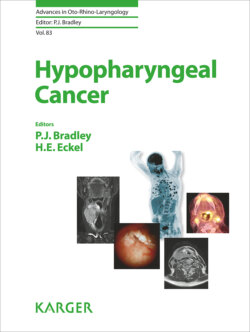Читать книгу Hypopharyngeal Cancer - Группа авторов - Страница 36
На сайте Литреса книга снята с продажи.
Volumetric Staging
ОглавлениеThe TNM classification is entirely based upon anatomic and clinical findings only, and while acceptable it has its limitations in the recent era of rapid advances in imaging, biology and therapeutic options, but has allowed for documentation and communication throughout the World and includes regions where advancements in imaging and biologic prognostic markers are unavailable [16, 27]. A retrospective population-based survival study of 595 patients with hypopharyngeal cancer was performed using the 8 available anatomical and clinically based staging systems, which predicted disease-specific survival. This study also found that the UICC/TNM 6th Edition (2002) though successful in creating statistically distinct groups did not perform as well as other stage grouping systems [28]. There has been much discussion about the merits and demerits of the current TNM classification and staging system, and there has been no change since 2002, specifically related to hypopharyngeal cancer [29, 30].
A staging system based on tumour volume instead of strict anatomic extent (TNM) has been reported as most relevant and being a greater significant prognostic factor in the management of head and neck cancer, and more so specifically for hypopharyngeal cancer [31, 32]. With the recent declining use of open surgery for advanced stage hypopharyngeal cancer and the shift to increasing use of radiotherapy and drug therapy, it would seem logical that the tumour volume of the T and the N disease would allow for better treatment planning and more so for non-surgical treatments. The majority of hypopharyngeal cancer patients will have had modern imaging performing prior to discussion of any treatment options and have included one or all methods: computer tomography (CT), magnetic resonance imaging and positron emission tomography, all of which delineate tumour volume.
The volumetric staging system for T stage disease has been proposed using 3 patient groups: “favourable,” “intermediate” and “unfavourable” [33]. Early work defined a T tumour volume of < 15 cm3 as “favourable” and > 70 cm3 as being unfavourable. Similarly the comparable volumetric system for N0 stage disease was suggested best represented the “favourable” group, N1–N2b, the “intermediate” group, and N2c/3 the “unfavourable” group. The majority of patients T1 and T2 were staged “favourable”, some T2, most T3, and some T4 were staged “intermediate” and the majority of T4 being in the “unfavourable” category, emphasising that T stage to be a poor reflection of tumour volume [33]. Others have reported that the critical cut-off point for separating “favourable” and “unfavourable” to be a mean primary tumour volume to range between 19.0 and 20.9 mL [31, 34]. Further studies need to be reported to gain a consensus on the cut-off points between the differing volumetric stages for hypopharyngeal disease.
One of the early criticisms of using volume has been that determining accurate dimensions is technically more difficult, requiring more manpower, and that volume measurements needs to be standardised [16, 27]. A study of target delineation of advanced hypopharyngeal cancer patients reported that the gross tumour volume (GTV) was on average 1.7 times larger than the volume of the tumour when compared with the excised specimen using whole-mounted hematoxylin-eosin stained sections. They and others conclude that by using a combination of the various validated modalities, imaging techniques would result in optimal GTV delineation of hypopharyngeal cancer and improve guidelines for GTV delineation for head and neck cancer in general [35, 36].
A clinical trial selecting patients with “intermediate-volume” (median range > 7 to < 30 mL) mainly piriform sinus sub-site (86%) hypopharyngeal cancer, with surgical salvage of nodal disease resulted in an overall survival and local control rates at 3 years were 91 and 88% [37]. Another study of 76 patients with advanced hypopharyngeal cancer assessed the GTV of the primary and nodal volumes, measured separately, reported that a GTV < 30 mL identified a “favourable” group for primary and nodal disease within patients staged III–IVA and are likely than not to respond to non-surgical treatment. They concluded that a combined modality treatment approach, surgery and non-surgery, needs to be explored for patients with larger primary and nodal tumour volumes [38].
